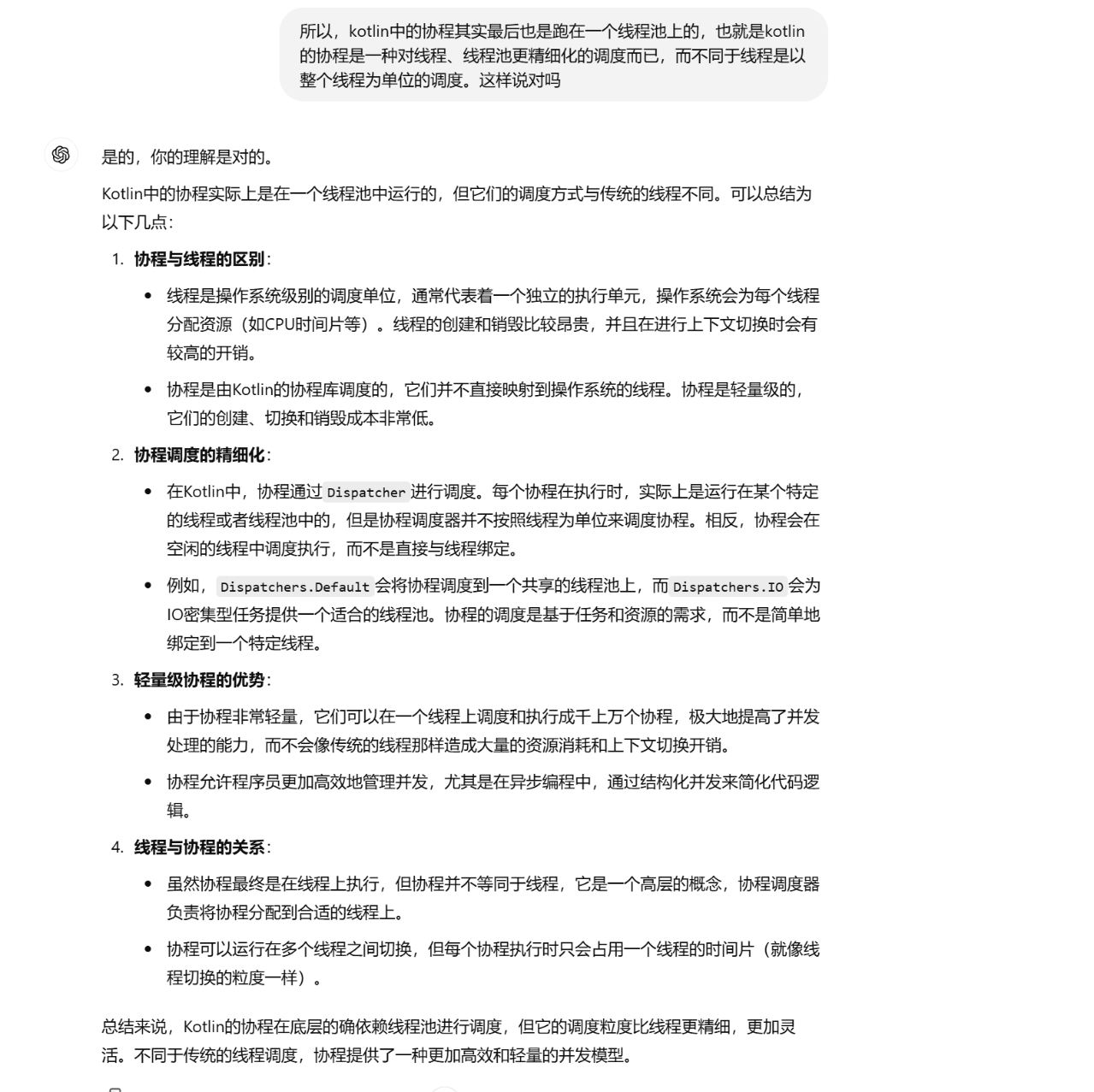Coroutines_Principle
Kotlin协程使用
所以,kotlin中的协程其实最后也是跑在一个线程池上的,也就是kotlin的协程是一种对线程、线程池更精细化的调度而已,而不同于线程是以整个线程为单位的调度。
而协程的suspend和resume其实也就是将需要挂起的代码块或者方法,通过编译器增加的语法糖包裹成状态机中的不同状态,然后根据运行和返回结果调用到对应的case而已,

Dispatchers
协程调度器是用来指定协程体在哪个线程中执行,Kotlin提供了几个调度器:
Default
默认选项,指定协程体在线程池中执行:
1 | GlobalScope.launch(Dispatchers.Default) { |
Main
指定协程体在主线程中执行。
IO
基于 Default 调度器背后的线程池(designed for offloading blocking IO tasks),因此从 Default 切换到 IO 不会触发线程切换:
1 | GlobalScope.launch(Dispatchers.Default) { |
Unconfined
协程体运行在父协程所在的线程:
1 | GlobalScope.launch(Dispatchers.Default) { |
CoroutineScope
1 | public interface CoroutineScope { |
GlobeScope
GlobeScope 启动的协程是一个单独的作用域,不会继承上层协程的作用域,其内部的子协程遵守默认的作用域规则。
coroutineScope
coroutineScope 启动的协程 cancel 时会 cancel 所有子协程,也会 cancel 父协程,子协程未捕获的异常也会向上传递给父协程。
supervisorScope
supervisorScope 启动的协程 cancel 和传递异常时,只会由父协程向子协程单向传播。MainScope 是 supervisorScope 作用域。
Android-Kotlin协程使用
MainScope
Android 中一般不建议使用 GlobalScope, 因为它会创建一个顶层协程,需要保持所有对 GlobalScope 启动的协程的引用,然后在 Activity destory 等场景的时候 cancel 掉这些的协程,否则就会造成内存泄露等问题。可以使用 MainScope:
1 | class CoroutineActivity : AppCompatActivity() { |
MainScope 的定义:
1 | public fun MainScope(): CoroutineScope = ContextScope(SupervisorJob() + Dispatchers.Main) |
调用 MainScope 协程作用域 的 cancel 函数 , 即可取消该协程作用域 , 同时,该协程作用域内的协程任务不管是否执行完毕 都一并取消 , 该函数是 CoroutineScope 的扩展函数 ;
只要是通过该 private val mainScope = MainScope() 协程作用域 启动的协程任务 , 如果取消 mainScope 协程作用域 , 则在该 协程作用域 中执行的 协程任务 , 都会被取消 ;
挂起函数中途被取消 会抛出 JobCancellationException 异常
LifecycleScope
关于 Lifecycle 可以参考 Android-Jetpack组件之Lifecycle。
添加依赖:
1 | implementation "androidx.lifecycle:lifecycle-runtime-ktx:2.2.0" |
源码如下:
1 | val LifecycleOwner.lifecycleScope: LifecycleCoroutineScope |
使用:
1 | // AppCompatActivity 实现了 LifecycleOwner 接口 |
LiveData协程
关于 LiveData 可以参考 Android-Jetpack组件之LiveData-ViewModel。
添加依赖:
1 | implementation "androidx.lifecycle:lifecycle-livedata-ktx:2.2.0" |
源码如下:
1 | fun <T> liveData( |
使用:
1 | // AppCompatActivity 实现了 LifecycleOwner 接口 |
ViewModel协程
关于 ViewModel 可以参考 Android-Jetpack组件之LiveData-ViewModel。
添加依赖:
1 | implementation "androidx.lifecycle:lifecycle-viewmodel-ktx:2.2.0" |
源码如下:
1 | val ViewModel.viewModelScope: CoroutineScope |
协程原理
suspend 的原理
简述:suspend其实也是回调,实现suspend的方法会被编译器替换为 多一个Continuation参数 的方法,Continuation实现了一个状态机,其中每个挂起点(suspend方法)都是一个状态,保存了下一步执行的CoroutineContext。
具体而言, 比如main中调用了suspend a(), suspend b(),那么实际上编译器会构造这么一个状态机:invokeSuspend() 中根据每个方法的执行结果,如a()如果耗时【即withContext(Dispatchers)/runBlocking之类的】则会return COROUTINE_SUSPENDED (即后续操作先不执行,也就是挂起了),等耗时执行完成后invokeSuspend()再被调用,此时状态改变,break走下一步b();如果a()不耗时则立即break,走到下一步b(); 如此往复,直到所有suspend方法执行完成,后正常执行其他代码
suspend是回调(Callback)理解
suspend其实不需要纠结神奇的「挂起」是什么意思或者拘泥于线程是怎么切换的。实际上suspend的背后是大家非常熟悉的回调。假设
postItem由三个有依赖关系的异步子任务组成:requestToken,createPost和processPost,这三个函数都是基于回调的 API:
2
3
4
5
6
7
8
9
10
11
12
13
14
15
16
fun requestToken(block: (String) -> Unit)
fun createPost(
token: String,
item: Item,
block: (Post) -> Unit)
)
fun processPost(post: Post)
fun postItem(item: Item) {
requestToken { token ->
createPost(token, item) { post ->
processPost(post)
}
}
}可以看到基于回调的 API 很容易造成大量缩进。如果代码中再加上一些条件、循环的逻辑,那么代码可读性会大大降低。Promise (Future) 等 API 以及 Android 社区很流行的 RxJava 通过链式调用在一定程度上消除了嵌套的问题。比如上面这个例子用 RxJava 实现的话:
2
3
4
5
6
7
fun createPost(token: String, item: Item): Observable<Post>
fun processPost(post: Post)
fun postItem(item: Item) = requestToken()
.flatMap { createPost(it, item) }
.flatMap { processPost(it) }但是 RxJava 这样的方案需要使用者掌握大量操作符,写复杂逻辑也很麻烦,会有一种被「困在」这个调用链里面的感觉。
kotlin 的 suspend 关键字可以帮助我们消除回调,用同步的写法写异步:
🏹代表挂起点(suspension point)
1 | suspend fun requestToken(): String |
由于 createPost 这些方法实际上是耗时的 IO 异步操作,需要等到拿到返回值才能执行后面的逻辑,但我们又不希望阻塞当前线程(通常是主线程),因此最终必须实现某种消息传递的机制,让后台线程做完耗时操作以后把结果传给主线程。
假设我们有了前面提到的三个基于回调的 API,实现 suspend 可以在编译的时候把每个挂起点 🏹 后面的逻辑包在一个 lambda 里面,然后去调用回调 API,最终生成类似嵌套的代码。但这样每一个挂起点在运行时都需要开销一个 lambda 对象。Kotlin 和许多其他语言都采用生成状态机的方式,性能更好。
具体来说,编译器看到 suspend 关键字会去掉 suspend ,给函数添加一个额外的 Continuation 参数。这个 Continuation 就代表了一个回调:
1 | public interface Continuation<in T> { |
Kotlin 编译器会给每个 suspend 的块生成一个 Continuation 的实现类,这个实现类是一个状态机,其中的状态对应于每个挂起点,保存了需要下一步继续执行所需要的上下文(即依赖的局部变量),类似下面的伪代码:
1 | suspend fun postItem(item: Item) { |
编译器将 suspend 编译成带有 continuation 参数的方法叫做 CPS (Continuation-Passing-Style) 变换。
使用 suspend 函数无须关心线程切换
suspend 提供了这样一个**约定(Convention)**:调用这个函数不会阻塞当前调用的线程。
但前提是这个
suspend函数实现正确,真正做到了不阻塞当前线程。单纯地给函数加上suspend关键字并不会神奇地让函数变成非阻塞的
这对 UI 编程是非常有用的,因为 UI 的主线程需要不断相应各种图形绘制、用户操作的请求,如果主线程上有耗时操作会让其他请求无法及时响应,造成 UI 卡顿。
Android 社区流行的网络请求库 Retrofit、官方出品的数据库 ORM Room 都已经通过提供 suspend API 的形式支持了协程。Android 官方也利用 Kotlin 扩展属性的方式给 Activity 等具有生命周期的组件提供了开启协程所需的 CoroutineScope ,其中的 context 指定了使用 Dispatchers.Main ,即通过 lifecycleScope 开启的协程都会被调度到主线程执行。因此我们可以在调用 suspend 函数,拿到结果后直接更新 UI,无须做任何线程切换的动作。这样的 suspend 函数叫作「main 安全」的。
1 | lifecycleScope.launch { |
这相比 callback 和 RxJava 的 API 是要好很多的。这些异步的 API 最终都得依靠回调,但回调回来在哪个线程需要调用方自己搞清楚,得看这些函数里面是怎么实现的。而有了 suspend 不阻塞当前线程的约定,调用方其实无须关心这个函数内部是在哪个线程执行的。
1 | lifecycleScope.launch(Dispatchers.Main) { |
比如上面这个代码块,我们指定这个协程块调度到主线程执行,里面调用了一个不知道哪里来的 suspend foo 方法。这个方法内部可能是耗时的 CPU 计算,可能是耗时的 IO 请求,但是我在写这个协程块的时候,其实并不需要关心这里面到底是怎么回事,运行在哪个线程。类似地,在阅读这段协程块的时候,我们可以清楚地知道眼前的这段代码会在主线程执行,suspend foo 里面的代码是一个潜在的耗时操作,具体在哪个线程执行是这个函数的实现细节,对于当前代码的逻辑是「透明」的。
但前提是这个 suspend 函数实现正确,真正做到了不阻塞当前线程。单纯地给函数加上 suspend 关键字并不会神奇地让函数变成非阻塞的,比如假设 suspend foo 里面的实现是这样的:
1 | // 😖 |
这里这个 suspend 函数的内部实现是一段耗时的 CPU 操作,类似地也可以想象成是一段时间复杂度特别高的代码。我们如果在主线程调用这个函数还是会阻塞 UI。问题出在这个 foo 函数的实现没有遵守 suspend 的语义,是错误的。正确的做法应该修改这个 foo 函数:
1 | suspend fun findBigPrime(): BigInteger = |
借助 withContext 我们把耗时操作从当前主线程挪到了一个默认的后台线程池。因此有人说,即使是用了协程,最终还是会「阻塞」某个线程,「所有的代码本质上都是阻塞式的」。这种理解可以帮助我们认识到 Android / JVM 上最终需要线程作为执行协程的载体,但忽略了阻塞和非阻塞 IO 之分。CPU 执行线程,而上面 BigInteger.probablePrime 是一个耗时的 CPU 计算,只能等待 CPU 把结果算出来,但 IO 造成的等待并不一定要阻塞 CPU。
链接
https://blog.yujinyan.me/posts/understanding-kotlin-suspend-functions/
Other
以GlobalScope.launch{ … } 为例,编译期通过编译时插入代码,将”…”协程体包裹封装成一个继承与SuspendLambda,而SuspendLambda是一个抽象类,继承于ContinuationImpl。
ContinuationImpl就是核心协程类Continuation接口的实现(一个Continuation就代表了一个协程)\
协程的启动是通过 BaseContinuationImpl.resumeWith 方法调用到了子类 SuspendLambda.invokeSuspend 方法,然后通过状态机来控制顺序运行。
Kotlin 编译器会为 协程体 生成继承自 SuspendLambda 的子类,协程的真正运算逻辑都在其 invokeSuspend 方法中。
Coroutines_Principle